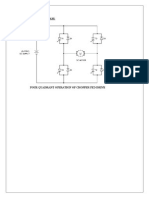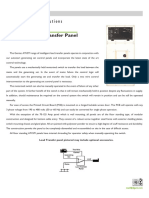Iec Lab Exp 06
Iec Lab Exp 06
Uploaded by
esumshunCopyright:
Available Formats
Iec Lab Exp 06
Iec Lab Exp 06
Uploaded by
esumshunOriginal Title
Copyright
Available Formats
Share this document
Did you find this document useful?
Is this content inappropriate?
Copyright:
Available Formats
Iec Lab Exp 06
Iec Lab Exp 06
Uploaded by
esumshunCopyright:
Available Formats
Experiment 6 Students’ Manual
American International University- Bangladesh
Department of Electrical and Electronic Engineering
EEE 2109: Introduction to Electrical Circuits Lab
Experiment#6:
Title: Transient Analysis of RC Series and RL series using PSPICE/MULTISIM.
Abstract:
PSpice/Multism is an electrical circuit simulation software with which circuits can be drawn,
checked, and simulated for finding unknown circuit parameter-values and graphs. The software
has component and device library which can be used for any types of construction, simulation, and
demonstration of circuits.
Introduction:
In this lab, the students will learn about the circuit simulation software PSpice/Multism. They will
also get accustomed to PSpice/Multism library. Besides, focus will be made over
1. Simulation of circuits by using components from the PSpice/Multism library,
2. Simulation of circuits by writing script files and to analyze obtained graphs and results.
Theory and Methodology:
Time Constant (τ): A measure of time required for certain changes in voltages and currents in RC
and RL circuits. Generally, when the elapsed time exceeds five-time constants (5τ) after switching
has occurred, the currents and voltages have reached their final value, which is also called steady-
state response.
The time constant of an RC circuit is the product of equivalent capacitance and the Thevenin
resistance,
τ = R×C (1)
The time constant of an RL circuit is the equivalent inductance divided by the Thevenin resistance,
τ = L/R (2)
Time Period (T): Time required to complete one cycle is called Time Period or the length of each
cycle of a pulse train is termed its time period (T).
Pulse width (tp): The pulse width of an ideal square wave is equal to half of the time period.
© Dept. of EEE, Faculty of Engineering, American International University-Bangladesh (AIUB)
Experiment 6 Students’ Manual
8K
8K
V1 = 0 V V1 = 0 V
V2 = 10V V2 = 10V
8UF 50H
TD = 0 S TD = 0 S
TR = 0S V PULSE TR = 0S V PULSE
TF = 0S TF = 0S
PW = 1S PW = 1S
Figire-1: RC circuit Figire2: RL circuit
Pre-Lab Homework:
Read about the characteristics of RC and RL series circuit during transient analysis from
“Alternating Current Circuit” by George F Corcoran and use PSPICE/Multism to generate the
output of the circuits provided in this lab sheet. Compare the wave shapes given in the textbook
with your results. Save the simulation results and bring it to the lab.
Apparatus:
• PC
• PSPICE/Multisim Simulating tools
Precautions:
Connecting of circuit should be done properly and PSPICE/MULTISM simulating software should
be properly installed using the information provided at the manual before starting the experimental
work.
Experimental Procedure (PSPICE):
Simulating Circuits by using Components from the PSpice library
1. Open the PSPICE Design Manager window: Start → Program → MicroSim Eval 8
2. Open schematic editor: Press Run Schematics icon from the bar on the left side of the
screen.
3. Select: Draw → Get New Part, then select and place each of the circuit elements one by
one (VPULSE for pulse type voltage source, R for resistor, C for capacitor and EGND for
ground). Join the elements by using the wire as necessary.
© Dept. of EEE, Faculty of Engineering, American International University-Bangladesh (AIUB)
Experiment 6 Students’ Manual
4. Change the label and magnitude of each element by double clicking on them and editing
as necessary.
5. Then go to Analysis → Setup → Select Transient and provide the necessary Values. And
swlwct automatically Run Probe after Simulation.
6. To execute the analysis, select: Analysis → Simulate or press F11. To view the analysis
result, select: Analysis → examine output.
7. Select Analysis → Simulate.
8. Select Trace → Add and select the desired traces.
9. Perform the text analysis as instructed.
Simulation and Measurement:
In PSpice window, construct the virtual RC and RL circuits as shown below. Simulate the
parametric wave shape for both the circuits. Compare the simulation results with your theoretical
data and comment on the differences (if any).
RC Circuit:
RL Circuit:
© Dept. of EEE, Faculty of Engineering, American International University-Bangladesh (AIUB)
Experiment 6 Students’ Manual
Experimental Procedure (MULTISIM):
Simulating Circuits by using Components from the Multism library
1. Open the Multisim software window: Start → Program → Multisim
2. Open component window from menu bar: Place → Components
3. Select Dc source/ Digital Clock/ Step Voltage source from components, a resistor, a
capacitor (for RC) or an inductor (for RL) and a ground source.
4. For Step voltage: Place → Components → Sources → Signal_Voltage_Sources → Step
Voltage.
5. Set the source, resistor, capacitor/inductor values properly.
6. Connect all the elements by using wire as necessary and label them properly.
7. Then go to Analysis and Simulation bar and change it to Transient: Analysis and
Simulation → Transient. And select the Initial condition to set to zero.
8. Choose the expected output variables from output window: Analysis and simulation →
Output → Add output variable.
9. Insert new expressions if needed: Analysis and simulation → Output → Add expression.
10. Now run the simulation for the designed circuit and analyze the output from the simulation
grapher view.
11. Perform the analysis as instructed.
Data Table:
RC Circuit (1 µF, 100Hz)
𝝉 Value Time % Charged 𝐕𝐜
Constant
1𝝉
2𝝉
3𝝉
4𝝉
5𝝉
RL Circuit (200 mH, 5Hz)
𝝉 Value Time % Charged 𝑰𝑳
Constant
1𝝉
2𝝉
3𝝉
4𝝉
5𝝉
© Dept. of EEE, Faculty of Engineering, American International University-Bangladesh (AIUB)
Experiment 6 Students’ Manual
Discussions:
i. In this experiment, RC, RL series circuits were constructed.
ii. Value time constant was modified as required and Vc, IL were measured. The obtained
data was inserted into the table.
iii. Relevant calculation was done using the experimental data.
iv. The analysis was completed effectively using τ = R×C and τ = L/R
v. Every mentioned step should be completed properly to make sure the simulation works
properly.
Questions for report writing:
1. Set the value of C= 1µf, R=1kΩ for RC, L= 200mH, R= 10Ω for RL circuit and simulate the
circuits.
2. Calculate the value of τ and tp for RL and RC circuit.
3. Verify the simulating result of the total circuit with theoretical result and Comment on the
result.
Discussion and Conclusion:
Interpret the data/findings and determine the extent to which the experiment was successful in
complying with the goal that was initially set. Discuss any mistake you might have made while
conducting the investigation and describe ways the study could have been improved.
Reference(s):
1. Robert L. Boylestad, ”Introductory Circuit Analysis”, Prentice Hall, 12th Edition, New York, 2010,
ISBN 9780137146666.
2. R.M. Kerchner and G.F. Corcoran, “Alternating Current Circuits”, John Wiley &
Sons, Third Ed., New York, 1956.
3. Lamar University website, [Cited: 12.01.2014]
Available: http://ee.lamar.edu/eelabs/elen2107/lab5.pdf
4. Lamar University website, [Cited: 12.01.2014]
Available: http://ee.lamar.edu/eelabs/elen2107/lab6.pdf
© Dept. of EEE, Faculty of Engineering, American International University-Bangladesh (AIUB)
You might also like
- Static Characteristics of SCR Experiment 1 Aim: To Study The Static Characteristics of SCR Apparatus: Multism Theory: SCR Works in Three Modes100% (1)Static Characteristics of SCR Experiment 1 Aim: To Study The Static Characteristics of SCR Apparatus: Multism Theory: SCR Works in Three Modes9 pages
- What Is TRIAC - Symbol, Construction, Working and Applications100% (1)What Is TRIAC - Symbol, Construction, Working and Applications20 pages
- Electrical Engineering Question Bank: Chapter3:TransformerNo ratings yetElectrical Engineering Question Bank: Chapter3:Transformer3 pages
- SCR DC Motor Forward/Reverse Control: Experiment #6No ratings yetSCR DC Motor Forward/Reverse Control: Experiment #66 pages
- Circuit Theory: Unit 3 Resonant CircuitsNo ratings yetCircuit Theory: Unit 3 Resonant Circuits36 pages
- To Analyze The Sinusoidal Response of RLC CircuitNo ratings yetTo Analyze The Sinusoidal Response of RLC Circuit4 pages
- Aim: To Test Differentiator and Integrator Circuits Using Ua741op-Amp100% (2)Aim: To Test Differentiator and Integrator Circuits Using Ua741op-Amp8 pages
- Experiment 3:-: Measurement of Average and Rms Value of Different Signal Waveforms100% (1)Experiment 3:-: Measurement of Average and Rms Value of Different Signal Waveforms6 pages
- Section 12-1 Analog-to-Digital Conversion: SolutionNo ratings yetSection 12-1 Analog-to-Digital Conversion: Solution4 pages
- Power Electronics Lab Experiment-No. 6 Single-Phase Full and Half Wave Controlled SCR Rectifier Aim: To Study and Analyze The Properties and The Characteristics of A Single-PhaseNo ratings yetPower Electronics Lab Experiment-No. 6 Single-Phase Full and Half Wave Controlled SCR Rectifier Aim: To Study and Analyze The Properties and The Characteristics of A Single-Phase6 pages
- Experiment # 5 To Examine The Diode Applications As: Diode Clippers/LimitersNo ratings yetExperiment # 5 To Examine The Diode Applications As: Diode Clippers/Limiters3 pages
- Department of Electrical & Computer Engineering: North South UniversityNo ratings yetDepartment of Electrical & Computer Engineering: North South University8 pages
- Analysis & Design of Different Astable Multivibrator Circuits For Various Applications in Communication SystemNo ratings yetAnalysis & Design of Different Astable Multivibrator Circuits For Various Applications in Communication System5 pages
- Experiment No. 09: Single Phase Cyclo Converter100% (1)Experiment No. 09: Single Phase Cyclo Converter7 pages
- Experiment 3: First Order Low Pass Filter and High Pass Filter100% (2)Experiment 3: First Order Low Pass Filter and High Pass Filter3 pages
- Department of Electrical and Electronics Engineering: List of Experiments SL - No Name of The Experiment Page NoNo ratings yetDepartment of Electrical and Electronics Engineering: List of Experiments SL - No Name of The Experiment Page No51 pages
- Observation of Polarity Test of A Single Phase Transformer100% (2)Observation of Polarity Test of A Single Phase Transformer3 pages
- Name: Date:: Experiment 02 Common Base Amplifier67% (3)Name: Date:: Experiment 02 Common Base Amplifier3 pages
- M.Tech: Power Electronics and Drives: Electrical Engineering DepartmentNo ratings yetM.Tech: Power Electronics and Drives: Electrical Engineering Department32 pages
- Experiment No: 4: TITLE: 4-Bit Comparator AIM: To Design 4-Bit Comparator Using IC 7485 Prior ConceptNo ratings yetExperiment No: 4: TITLE: 4-Bit Comparator AIM: To Design 4-Bit Comparator Using IC 7485 Prior Concept43 pages
- Channel Length Modulation: A Second Order Effect of MOSFETNo ratings yetChannel Length Modulation: A Second Order Effect of MOSFET8 pages
- ECE 027 - Module 5 Field Effect TransistorNo ratings yetECE 027 - Module 5 Field Effect Transistor102 pages
- Ell100 Lab Report: Single Phase Transformer B-H LoopNo ratings yetEll100 Lab Report: Single Phase Transformer B-H Loop10 pages
- EXP9 - Study of JFET and MOSFET Characterization.No ratings yetEXP9 - Study of JFET and MOSFET Characterization.17 pages
- IEC - EXP - 7 - Student Manual Transient AnalysisNo ratings yetIEC - EXP - 7 - Student Manual Transient Analysis4 pages
- Design of Electrical Circuits using Engineering Software ToolsFrom EverandDesign of Electrical Circuits using Engineering Software ToolsNo ratings yet
- Class XII Chemistry Notes Chapter 5 - Coordination CompoundsNo ratings yetClass XII Chemistry Notes Chapter 5 - Coordination Compounds28 pages
- Assessment: Test 1: Chemical Engineering ThermodynamicsNo ratings yetAssessment: Test 1: Chemical Engineering Thermodynamics2 pages
- Antenna & Wave Propagation Assignment 1 (MATLAB)No ratings yetAntenna & Wave Propagation Assignment 1 (MATLAB)3 pages
- Static Characteristics of SCR Experiment 1 Aim: To Study The Static Characteristics of SCR Apparatus: Multism Theory: SCR Works in Three ModesStatic Characteristics of SCR Experiment 1 Aim: To Study The Static Characteristics of SCR Apparatus: Multism Theory: SCR Works in Three Modes
- What Is TRIAC - Symbol, Construction, Working and ApplicationsWhat Is TRIAC - Symbol, Construction, Working and Applications
- Electrical Engineering Question Bank: Chapter3:TransformerElectrical Engineering Question Bank: Chapter3:Transformer
- SCR DC Motor Forward/Reverse Control: Experiment #6SCR DC Motor Forward/Reverse Control: Experiment #6
- Aim: To Test Differentiator and Integrator Circuits Using Ua741op-AmpAim: To Test Differentiator and Integrator Circuits Using Ua741op-Amp
- Experiment 3:-: Measurement of Average and Rms Value of Different Signal WaveformsExperiment 3:-: Measurement of Average and Rms Value of Different Signal Waveforms
- Section 12-1 Analog-to-Digital Conversion: SolutionSection 12-1 Analog-to-Digital Conversion: Solution
- Power Electronics Lab Experiment-No. 6 Single-Phase Full and Half Wave Controlled SCR Rectifier Aim: To Study and Analyze The Properties and The Characteristics of A Single-PhasePower Electronics Lab Experiment-No. 6 Single-Phase Full and Half Wave Controlled SCR Rectifier Aim: To Study and Analyze The Properties and The Characteristics of A Single-Phase
- Experiment # 5 To Examine The Diode Applications As: Diode Clippers/LimitersExperiment # 5 To Examine The Diode Applications As: Diode Clippers/Limiters
- Department of Electrical & Computer Engineering: North South UniversityDepartment of Electrical & Computer Engineering: North South University
- Analysis & Design of Different Astable Multivibrator Circuits For Various Applications in Communication SystemAnalysis & Design of Different Astable Multivibrator Circuits For Various Applications in Communication System
- Experiment 3: First Order Low Pass Filter and High Pass FilterExperiment 3: First Order Low Pass Filter and High Pass Filter
- Department of Electrical and Electronics Engineering: List of Experiments SL - No Name of The Experiment Page NoDepartment of Electrical and Electronics Engineering: List of Experiments SL - No Name of The Experiment Page No
- Observation of Polarity Test of A Single Phase TransformerObservation of Polarity Test of A Single Phase Transformer
- M.Tech: Power Electronics and Drives: Electrical Engineering DepartmentM.Tech: Power Electronics and Drives: Electrical Engineering Department
- Experiment No: 4: TITLE: 4-Bit Comparator AIM: To Design 4-Bit Comparator Using IC 7485 Prior ConceptExperiment No: 4: TITLE: 4-Bit Comparator AIM: To Design 4-Bit Comparator Using IC 7485 Prior Concept
- Channel Length Modulation: A Second Order Effect of MOSFETChannel Length Modulation: A Second Order Effect of MOSFET
- Ell100 Lab Report: Single Phase Transformer B-H LoopEll100 Lab Report: Single Phase Transformer B-H Loop
- Design of Electrical Circuits using Engineering Software ToolsFrom EverandDesign of Electrical Circuits using Engineering Software Tools
- Class XII Chemistry Notes Chapter 5 - Coordination CompoundsClass XII Chemistry Notes Chapter 5 - Coordination Compounds
- Assessment: Test 1: Chemical Engineering ThermodynamicsAssessment: Test 1: Chemical Engineering Thermodynamics

























































































